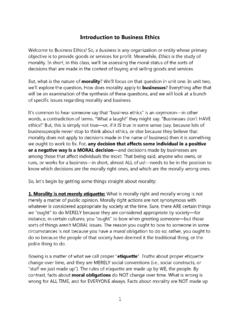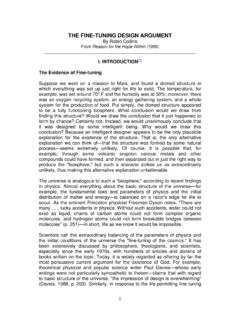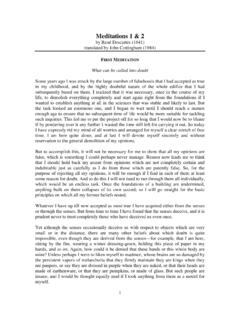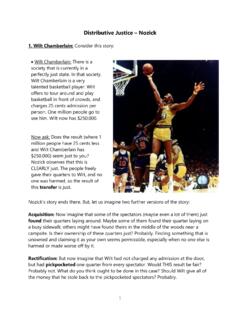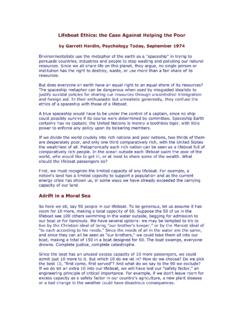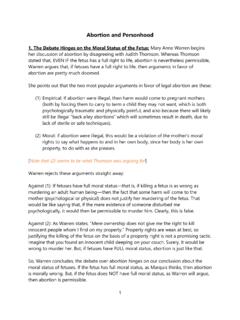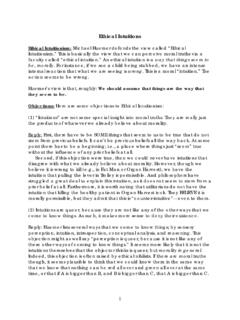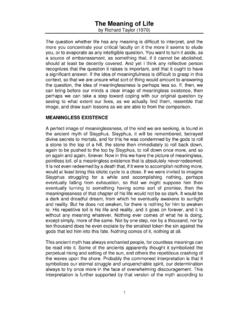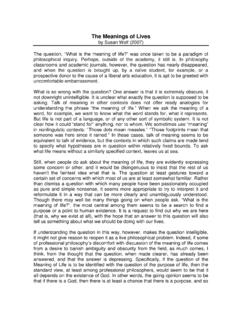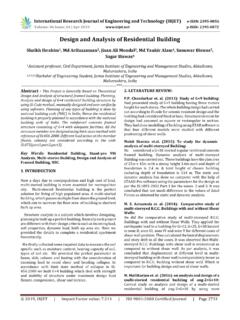Transcription of 6.6 Common Argument Forms and Fallacies
1 1 Common Argument Forms and Fallacies 1. Common Valid Argument Forms : In the previous section ( ), we learned how to determine whether or not an Argument is valid using truth tables. There are certain Forms of valid and invalid Argument that are extremely Common . If we memorize some of these Common Argument Forms , it will save us time because we will be able to immediately recognize whether or not certain arguments are valid or invalid without having to draw out a truth table. Let s begin: 1. Disjunctive Syllogism: The following Argument is valid: The coin is either in my right hand or my left hand. It s not in my right hand. So, it must be in my left hand. Let R = The coin is in my right hand and let L = The coin is in my left hand . The Argument in symbolic form is this: R L ~R _____ L Any Argument with the form just stated is valid.
2 This form of Argument is called a disjunctive syllogism. Basically, the Argument gives you two options and says that, since one option is FALSE, the other option must be TRUE. 2. Pure Hypothetical Syllogism: The following Argument is valid: If you hit the ball in on this turn, you ll get a hole in one; and if you get a hole in one you ll win the game. So, if you hit the ball in on this turn, you ll win the game. Let B = You hit the ball in on this turn , H = You get a hole in one , and W = you win the game . The Argument in symbolic form is this: B H H W _____ B W Any Argument with the form just stated is valid. This form of Argument is called a pure hypothetical syllogism. Basically, the Argument states a chain of reasons, where the first thing is connected to a second, and the second to a third, so the first is ultimately also connected to the third.
3 2 3. Modus Ponens (affirming the antecedent): The following Argument is valid: If you have a driver s license, then you must have taken the driver s test. You do have a driver s license. So, you must have taken the driver s test. Let L = You have a driver s license and T = You have taken the driver s test . The Argument in symbolic form is this: L T L _____ T Any Argument with the form just stated is valid. This form of Argument is called by the Latin phrase, modus ponens . We ll call it affirming the antecedent . Basically, the Argument states that, given a first thing, a second thing is true. It then AFFIRMS that the first thing is true. So, the second thing must also be true. 4. Modus Tollens (denying the consequent): The following Argument is valid: If you have a driver s license, then you must have taken the driver s test.
4 You have not taken the driver s test. So, you must not have a driver s license. Let L = You have a driver s license and T = You have taken the driver s test . The Argument in symbolic form is this: L T ~T _____ ~L Any Argument with the form just stated is valid. This form of Argument is called by the Latin phrase, modus tollens . We ll call it denying the consequent . Basically, the Argument states that, given a first thing, a second thing is true. It then DENIES that the second thing is true. So, the first thing must also not be true. 2. Common Invalid Argument Forms : There are two very Common INVALID Argument Forms which look a lot like modus ponens and modus tollens, but are mistaken. 1. Affirming the Consequent: The following Argument is invalid: If you were standing out in the rain, then you would be wet now.
5 You are wet now; so, you must have been standing out in the rain. 3 Let R = You were standing out in the rain and let W = You are wet now . The Argument in symbolic form is this: R W W _____ R arguments with this form are generally invalid. This form of Argument is called affirming the consequent . Basically, the Argument states that, given a first thing, a second thing is true. It then AFFIRMS that the second thing is true, and concludes from this that the first thing must also be true. But, this sort of inference is mistaken. For instance, just because you are wet does not guarantee that you were just standing out in the rain. Perhaps you just jumped into a pool, or into the shower. Or perhaps someone just poured a bucket of water on you. We cannot conclude for sure from the fact that you are soaking wet that you were outside in the rain.
6 2. Denying the Antecedent: The following Argument is invalid: If you were standing out in the rain, then you would be wet now. You were not standing out in the rain. So, you must not be wet now. Let R = You were standing out in the rain and let W = You are wet now . The Argument in symbolic form is this: R W ~R _____ ~W arguments with this form are generally invalid. This form of Argument is called denying the antecedent . Basically, the Argument states that, given a first thing, a second thing is true. It then DENIES that the first thing is true, and then concludes from this that the second thing must also NOT be true. But, this sort of inference is mistaken. For instance, just because you were not just standing in the rain does not guarantee that you are not soaking wet right now.
7 Again, perhaps you just jumped into a pool, or into the shower. Or perhaps someone just poured a bucket of water on you. We cannot conclude for sure from the fact that you were not just outside in the rain that you are not soaking wet now. 4 Note: If an Argument has one of the VALID Argument Forms , we CAN infer that it is valid for sure. But, if an Argument has one of the INVALID Argument Forms , we CANNOT infer that it is invalid for sure. For instance, the following Argument has the same form as the invalid affirming the consequent form. However, the following Argument is VALID: (A B) (A B) A B _____ A B Let p = (A B) and let q = (A B) . The Argument in symbolic form is this: p q q _____ p Since this only occurs in more complicated arguments , however, you can ignore this sort of exception in this course.
8 3. Common Valid Dilemma Forms : There are two more valid Argument Forms . These come in the form of DILEMMAS. 1. Constructive Dilemma: The following Argument is valid: If you take Logic, you will have to do a lot of homework; but, if you take Ethics, you will have to write a lot of papers. Since you must take either Logic or Ethics, you will either have to do a lot of homework or write a lot of papers. Let L = You take Logic , H = You will do a lot of homework , E = You take Ethics , and P = You will write a lot of papers . The Argument in symbolic form is this: (L H) (E P) L E _____ H P Any Argument with the form just stated is valid. This form of Argument is called a constructive dilemma . Basically, the Argument states that two conditionals are true, and that either the antecedent of one or the other must be true; and, because one of the two antecedents must be true, it follows that one of the two consequents must also be true.
9 5 2. Destructive Dilemma: The following Argument is valid: If you take Logic, you will have to do a lot of homework; but, if you take Ethics, you will have to write a lot of papers. Since you either don t want to do a lot of homework or you don t want to write a lot of papers, you should either not take Logic or not take Ethics. Let L = You take Logic , H = You will do a lot of homework , E = You take Ethics , and P = You will write a lot of papers . The Argument in symbolic form is this: (L H) (E P) ~H ~P _____ ~L ~E Any Argument with the form just stated is valid. This form of Argument is called a destructive dilemma . Basically, the Argument states that two conditionals are true, and that either the consequent of one or the other must be true; and, because one of the two consequents must be false, it follows that one of the two antecedents must also be false.
10 4. Refuting Dilemmas: Remember that a successful Argument must be both VALID and SOUND (that is, they must have a valid Argument form, and all of the premises must be true). Since both of the dilemma Forms we just looked at are VALID, if we want to reject the conclusion of a valid dilemma, we must show that they are not SOUND. In short, if we want to refute a valid dilemma, we must show that one of the premises is false. We can do this in one of two ways: (1) Grasp the dilemma by the horns: The two Forms of dilemma that we just looked at have two premises; the first is a conjunction, and the second is a disjunction. Grasping the dilemma by the horns involves rejecting the conjunction premise. To do this, we must show that one of the conjuncts is false. Let s take the Argument above about taking Ethics and Logic: If you take Logic, you will have to do a lot of homework; but, if you take Ethics, you will have to write a lot of papers.
